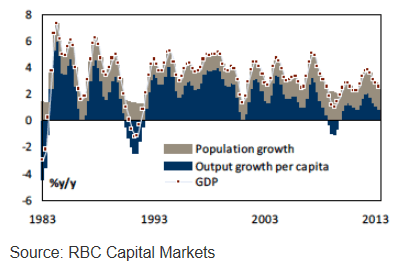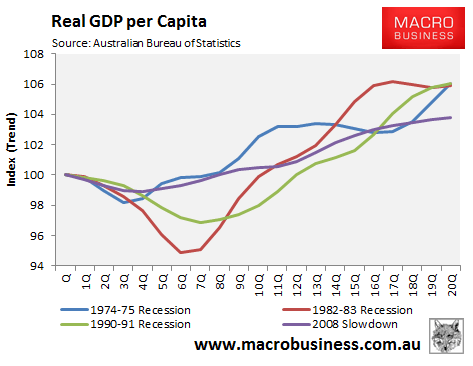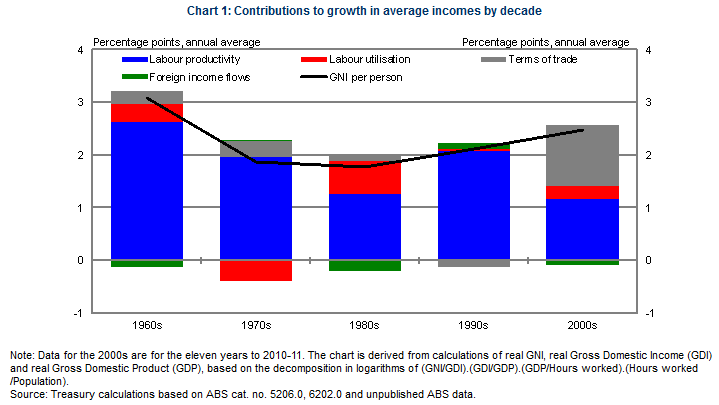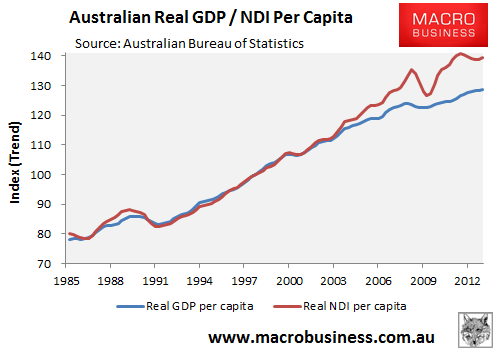
JP Morgan has released an optimistic report today arguing that the unwinding of Australia’s mining investment boom will weigh on growth over the the next two years, but that Australia will easily avoid a recession.
According to JP Morgan, nimble policy making, exchange rate flexibility, and growth in commodity exports will combine to manage the post-boom adjustment, with unemployment only forecast to peak at 6.5% by mid-2014.
That said, JP Morgan does point out that because Australia has avoided a recession for such a long period of time, the risk of a recession is “inevitably higher now than usual; the economy has built up vulnerabilities over time that have been masked by the continued growth in output and national income… the downside of avoiding recession is that Australia has carried these excesses through a succession of growth cycles”.
Among these vulnerabilities includes very high household debt levels, expensive housing, and weak productivity growth owing to a lack of reform. Growth has also become narrowly focussed on mining exports targeted at China.
Recessions on average in Australia occurred every six years in the decades leading up to the last downturn in the early 1990s.
…not only does an extended period without adjustment raise the risk of recession, it means the downturn, when inevitably it comes, probably will be more painful than if Australia had suffered more frequent downturns. The deleveraging of the household sector, for example, could be accelerated as the jobless rate rises, and there could be a marked adjustment in house prices, and not just relative to income. Then, the onus would return to governments and firms to make more hard-won productivity improvements.
Nevertheless, despite these risks, JP Morgan believes that “the economy will transition away from mining sufficiently smoothly to avoid recession once again”.
The evolution of the mining boom from the investment phase to the production phase is broadly on track, according to JP Morgan, with export volumes lifting as the peak in mining investment approaches. However, employment during the production phase is much less labour-intensive than the investment phase, with employment in the multi-billion dollar LNG projects “15-20 times higher in the construction phase than in production”.
The rebound in dwelling construction has also been “underwhelming… languish[ing] below the levels of two decades ago”. Meanwhile, “capital spending in domestically focused industries like manufacturing, transport, and retailing is falling”. JP Morgan also does not believe that the public sector is likely to provide much stimulus, nor will households materially lift their borrowings.
Accordingly, JP Morgan forecasts that: “the Australian economy essentially will be left with rising export volumes (we anticipate growth of 6% in 2013 and 5% in 2014) and a much-hoped-for lift in residential investment to fill the gap left after mining investment peaks. These contributors won’t be sufficient to plug the gap, so growth will be sub-trend; our forecasts for GDP growth in CY13 and CY14 are unchanged at 2.4% and 2.75%, respectively.”
It also sees further interest rate cuts (it forecasts another 25bps cut in November), as well as further falls in the Australian dollar, which should cushion growth.
My own view is that whether Australia avoids a technical recession or not misses the point: the coming slowdown will be enduring and feel like a recession for most people.
Although Australia’s real GDP has averaged a respectable 2.4% growth per annum since the onset of the Global Financial Crisis (GFC), and is now 12.2% higher than in September 2008, real per capita GDP has averaged only 0.8% growth per annum, and is only 3.8% higher today in trend terms than in June 2008, thanks to high population growth (see next chart).

Indeed, growth in real per capita GDP since the onset of the GFC has been weak from an historical perspective, lagging the recoveries following the 1970s, 1980s and 1990s recessions (see next chart).

With the economy set to slow significantly as the mining boom unwinds, growth in real per capita GDP risks turning negative over the next few years, meaning the average Australian would be going backwards, with growth then likely to remain sub-par for an extended period of time.
Bigger risks are on the horizon for incomes and employment.
According to the Australian Treasury, half of the growth in average incomes over the 2000s was accounted for by the rising terms-of-trade (see next chart).

Whereas in prior decades, Australian incomes grew primarily on the back of rising productivity and/or improved labour force participation, over the 2000s they grew because the price of the things that we export – mainly commodities such as iron ore, coal, natural gas, and coal – rose dramatically on the back of China’s insatiable demand for resources.
In turn, Australia effectively received a large pay rise, since more imports could be bought with a given volume of exports. As a result, real average national disposable income (NDI) rose at a much faster rate than justified by the growth of the Australian economy, as measured by real per capita GDP (see next chart).

The sharp rise in commodity prices also underpinned government budgets, which reaped the benefit of rising personal and company taxes, as well as resource rent taxes. Some of this extra taxation revenue was also re-distributed to households via tax cuts and welfare payments, thereby further inflating disposable incomes.
The problem going forward is that commodity prices and the terms-of-trade are likely to trend lower. This will drag heavily on income growth, with real per capital NDI now likely to grow at a much slower rate than real per capita GDP (i.e. the red line above will converge with the blue line).
The unwinding of the mining boom is also likely to weigh heavily on the labour market.
According to recent RBA estimates, the mining sector accounts for nearly 10% of Australian employment. Most of these jobs are in areas directly related to mining capex, such as construction workers, engineers, and other mining services. As mining projects finish, so will these jobs, which is likely to lead to a material increase in unemployment unless other areas of the economy can expand sufficiently to fill the void (unlikely in our view).
The way we see it, the best case scenario for the Australian economy is a dour struggle against the headwinds of falling mining investment. Growth based upon net exports will still see unemployment slowly climb and income growth fall even if successful.

